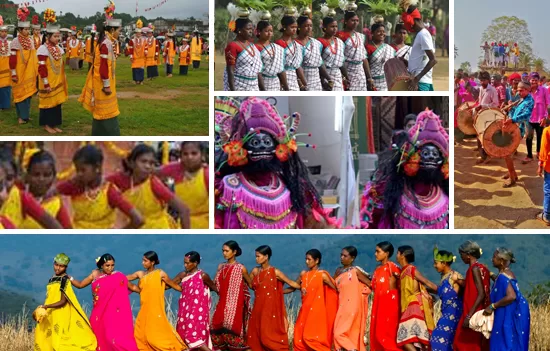Introduction: Adivasi Culture and History in India
The Adivasi people, often referred to as the indigenous tribes of India, embody a rich cultural heritage that has been nurtured over millennia. As the original inhabitants of the Indian subcontinent, their history is marked by resilience, adaptability, and a deep connection to the land. This article explores the fascinating history, culture, and contemporary challenges faced by the Adivasi communities, shedding light on their importance in India’s social fabric.

Historical Background
The term “Adivasi” comes from the Hindi words “adi,” meaning “earliest,” and “vasi,” meaning “inhabitant.” Coined in the 1930s during a movement to forge a collective identity among India’s indigenous peoples, Adivasi groups are not monolithic; they comprise over 200 distinct tribes, each with its own language, customs, and traditions. According to the 2011 Census, Adivasis make up approximately 8.6% of India’s population, totaling around 104.3 million individuals.
Historically, Adivasis inhabited vast areas of the subcontinent but have faced significant displacement and marginalization, particularly since the invasions of Indo-Aryan tribes around 3,000 years ago. Unlike other communities, Adivasis were not fully integrated into the Hindu caste system, which allowed them to maintain unique cultural practices and beliefs. Their rich oral traditions, folklore, and rituals are essential aspects of their identity, passed down through generations.
Cultural Practices
Adivasi culture is incredibly diverse, reflecting the various environments in which these communities live—from dense forests to mountainous terrains. Their way of life is intimately connected to nature, with many relying on agriculture, hunting, and gathering for their livelihoods.
Festivals and Rituals
Festivals play a crucial role in Adivasi life, often tied to agricultural cycles and seasonal changes. Celebrations such as Holi, Diwali, and local harvest festivals are marked by vibrant dances, music, and rituals that honor nature and ancestral spirits.
Art and Craft
Adivasis are renowned for their artistic expressions, which include intricate handicrafts, textiles, and tribal jewelry. These art forms often tell stories of their heritage and serve as vital means of cultural preservation.
Spiritual Beliefs
Adivasi spiritual beliefs are deeply rooted in nature, often incorporating elements of animism and ancestor worship. Their connection to the land is sacred, and they see themselves as custodians of the environment, embodying sustainable practices that have been honed over generations.
Political and Social Struggles
Despite their rich cultural heritage, Adivasi communities face numerous challenges in contemporary India. Economic exploitation, land displacement, and social discrimination remain prevalent issues. Large-scale industrial projects, mining operations, and deforestation have further threatened their livelihoods and cultural practices.
Constitutional Recognition
Following India’s independence, the 1950 Constitution recognized Adivasis as “scheduled tribes,” granting them certain protective provisions. However, implementation has often fallen short, with bureaucratic hurdles and corruption impeding progress. The Forest Rights Act of 2006 aimed to restore land rights to Adivasi communities, yet many still struggle to access these entitlements.
Socio-Economic Disparities
Adivasi communities are often among the poorest in India, facing barriers to education, healthcare, and employment. Despite affirmative action policies intended to improve their socio-economic status, the benefits have been uneven, with many Adivasis unable to leverage opportunities in higher education or government jobs.
Current Challenges
The contemporary plight of Adivasi communities is marked by several key issues:
- Land Rights: Displacement from ancestral lands due to industrialization and environmental degradation has left many Adivasis vulnerable. They continue to fight for recognition and restitution of their land rights.
- Cultural Erosion: As modernization encroaches upon traditional lifestyles, many Adivasi cultures face the threat of extinction. Efforts to assimilate Adivasis into mainstream society often undermine their unique identities and traditions.
- Social Stigma: Prejudices and stereotypes continue to marginalize Adivasi communities. They are frequently viewed as “primitive” or “backward,” which perpetuates cycles of poverty and exclusion.
Voices of Resistance
Despite the numerous challenges, Adivasi communities are increasingly vocal about their rights and aspirations. Grassroots organizations and activists advocate for their cause, seeking to empower Adivasi voices in political and social spheres. Movements such as the Jharkhand Mukti Morcha have played significant roles in advocating for the rights and recognition of Adivasis in the region.
Conclusion
The Adivasi people are a vital part of India’s cultural landscape, representing the country’s rich diversity and heritage. Their history, rooted in resilience and adaptability, is a testament to their enduring spirit. Acknowledging and respecting Adivasi culture is essential for fostering a more inclusive society that honors the contributions of all its people. As India moves forward, it must embrace its indigenous heritage, ensuring that the voices of Adivasi communities are heard and respected. Only then can the nation truly reflect the richness of its diverse cultural mosaic.
📚 Take Your Trading And Financial Skills to the Next Level!
If you enjoyed this post, dive deeper with our Profitable Trader Series—a step-by-step guide to mastering the stock market.
- Stock Market 101: Profits with Candlesticks
- Stock Market 201: Profits with Chart Patterns
- Stock Market 301: Advanced Trade Sheets
Start your journey now!
👉 Explore the Series Here
For Regular News and Updates Follow – Sentinel eGazette
FAQs
Q1: What is the meaning of the term ‘Adivasi’?
A: The term ‘Adivasi’ derives from Hindi, where ‘adi’ means ‘earliest’ and ‘vasi’ means ‘inhabitant,’ referring to India’s indigenous people.
Q2: How many Adivasi tribes are there in India?
A: There are over 200 distinct Adivasi tribes in India, each with unique languages, cultures, and traditions.
Q3: What are the main economic activities of Adivasi communities?
A: Adivasi communities primarily engage in agriculture, hunting, gathering, and crafts, often relying heavily on forest resources.
Q4: What challenges do Adivasis face today?
A: Adivasis face challenges such as land displacement, socio-economic disparities, cultural erosion, and social stigma.
Q5: How has the Indian government recognized Adivasi rights?
A: The Indian government recognizes Adivasi rights through special provisions in the Constitution, but implementation has been inconsistent.